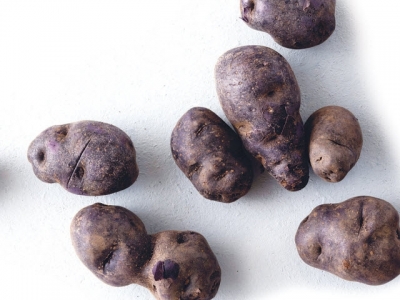Cropped: Potatoes

Poor potatoes. They are the humble workhorse of the vegetable world, usually taken for granted and often overlooked in favor of more exotic options. And yet this everyday vegetable is a success story, an important staple around the world that stores well for long periods of time, not to mention an unbeatable comfort food when combined with butter, cheese and heavy cream.
Photograph: Sofood/Alamy
The potato, Solanum tuberosum, was originally cultivated in what is now Peru some 7,000 to 10,000 years ago. There, in the high, cold Andes, the traditional way to preserve the vegetable was by freeze-drying. In the 16th century, the Spanish conquistadors brought the potato back to Europe. But this tuber failed to catch on at first.
Over the centuries, a handful of European rulers recognized the potato’s potential as a useful food crop and tried to popularize it. Marie Antoinette even wore potato flowers in her hair in an attempt to make it fashionable. But it was the fact that the potato could be grown successfully on fallow land that caused it to be cultivated on a large scale in Europe by the end of the 18th century. Ireland’s dependency on the potato to feed its people received a devastating blow with potato blight, which caused the Irish Potato Famine of 1845, resulting in mass death and immigration.
The potato’s characteristically delicate flavor and starchy texture makes it a versatile ingredient, though usually served as an accompaniment rather than as a highlight. “They are the perfect vehicle for almost any flavor, ranging from coconut to olives, and black garlic to turmeric,” says Anna Hanson, chef and owner of the acclaimed Modern Pantry restaurant in London. “They are fundamental to so many classic dishes from all over the world, from gnocchi to aloo gobi.”
One reason for the potato’s success is its sheer number of varieties literally thousands of different types of potato exist. Broadly speaking, however, there are two categories of cooking potatoes: “floury” (or starchy) and “waxy,” terms that reflect their textures when cooked. So choose appropriately: Floury potatoes, such as Russet potatoes, have a higher starch content, which when cooked results in a dry, fluffy texture, preferable for making mashed potatoes and french fries. Waxy potatoes like French Fingerlings have less starch and cells that stick together when cooked, meaning that they are better able to retain their shape when sliced and are great in potato salads.
In Britain, Carroll’s Heritage Potatoes, a farm run by Anthony and Lucy Carroll, is working to revitalize the image of the spud. They specialize in heritage varieties, which have a “marvelous taste,” explains Lucy, but are difficult to grow commercially they are more susceptible to disease, offer a lower yield and have unusual shapes that make them tricky to harvest without bruising. Among the Carrolls’ specialties are colorful Shetland Black, Salad Blue and Mr. Little’s Yetholm Gypsy. The Yetholm Gypsy, a Northumbrian variety, is “wonderful to look at because it’s got a red, white and blue skin,” says Lucy. “Chefs like to roast it, skin on.”
You don’t need lots of land to grow potatoes at home just a pot with some seed potatoes will do. Chitting (also called “greenspouting”) your potatoes, or letting them grow shoots before planting, will help with a quicker and even more productive harvest. Plant potatoes in spring and then harvest in summer or autumn, depending on whether you’re growing “earlies” or maincrop potatoes (different varieties that grow for varying lengths of time). But don’t forget that all potatoes love sun and water. When it comes time to harvest, be sure to enjoy it. There is something magical about digging your fingers into the soil to find that the initial solitary tuber has multiplied into a handful of potatoes dinner!
Jansson’s Temptation
This is a classic Swedish recipe, traditionally served on its own or as an accompaniment to grilled or roasted meats, like beef. If possible, try and use authentic Swedish “anchovies” (which are, actually, sprat fillets) preserved in a spiced, sweet cure.
- 2 tablespoons butter
- 2 onions, peeled and finely sliced
- 6 waxy potatoes such as French Fingerlings (approximately 1 1⁄2 pounds), peeled and sliced in short, thin, matchstick-sized strips
- 1 × 125g tin of Swedish anchovies, chopped in half, or 6 anchovy fillets in oil, cut into small pieces 1
- 3⁄4 cups heavy cream
- Salt and pepper
Preheat oven to 350 F. Heat half the butter in heavy frying pan over medium heat. Add onion and fry gently for 15 to 20 minutes, stirring, until softened and light golden-brown. Place thin layer of potato in well-buttered, ovenproof dish. Top with some fried onion and a few pieces of Swedish anchovy. Repeat, ending with layer of potato. Dot top with remaining butter cut into small pieces. In small pan, gently heat cream to simmer, and season with salt and pepper. Pour hot cream over potato mixture. Cover with foil and bake for 30 minutes. Remove foil and bake for 30 minutes more. The finished dish should be golden-brown and crispy on top, with soft potatoes underneath. Serve at once.
Related news
Tools

Phối trộn thức ăn chăn nuôi

Pha dung dịch thủy canh

Định mức cho tôm ăn

Phối trộn phân bón NPK

Xác định tỷ lệ tôm sống

Chuyển đổi đơn vị phân bón

Xác định công suất sục khí

Chuyển đổi đơn vị tôm

Tính diện tích nhà kính

Tính thể tích ao



 Cropped: Bananas
Cropped: Bananas  How to Grow Fruits, Vegetables, and Herbs in…
How to Grow Fruits, Vegetables, and Herbs in…